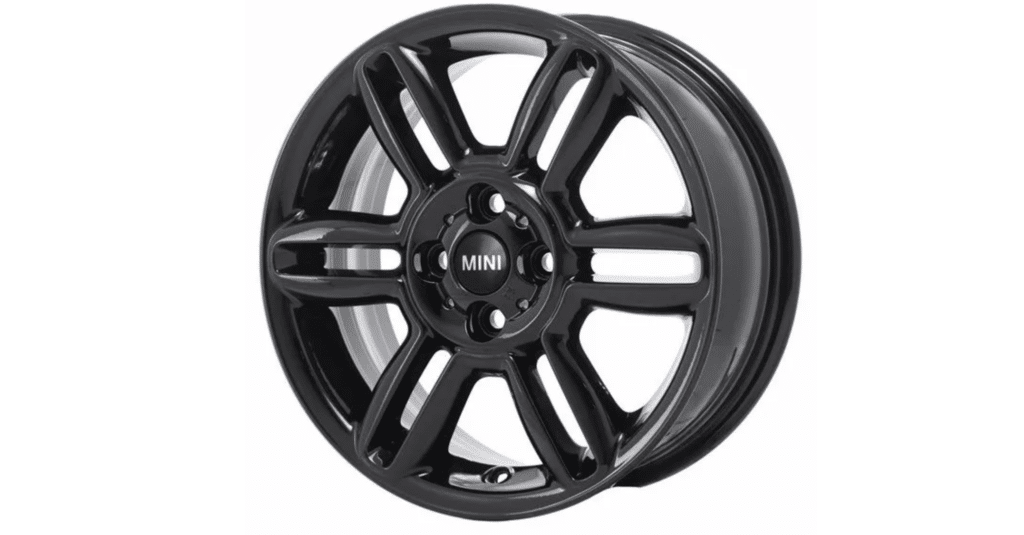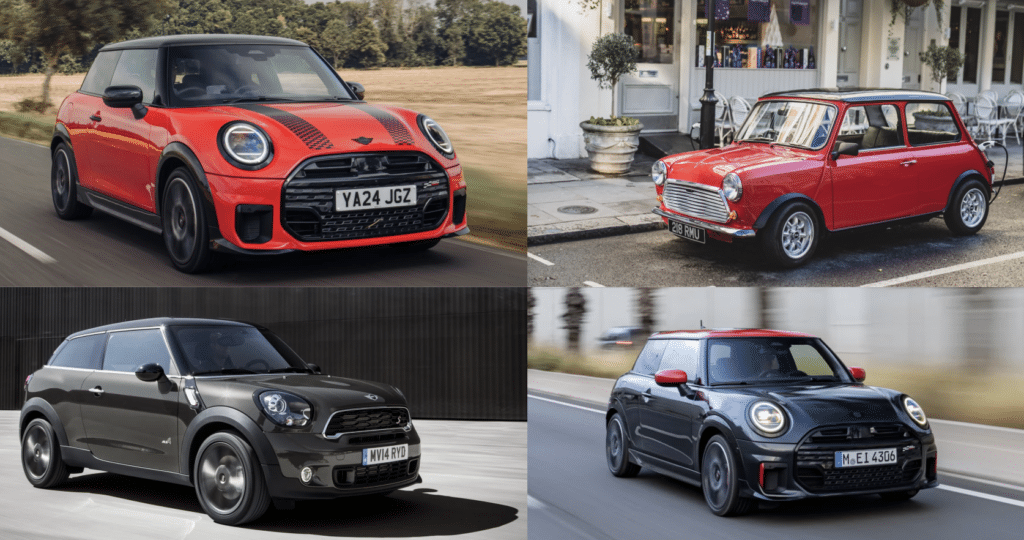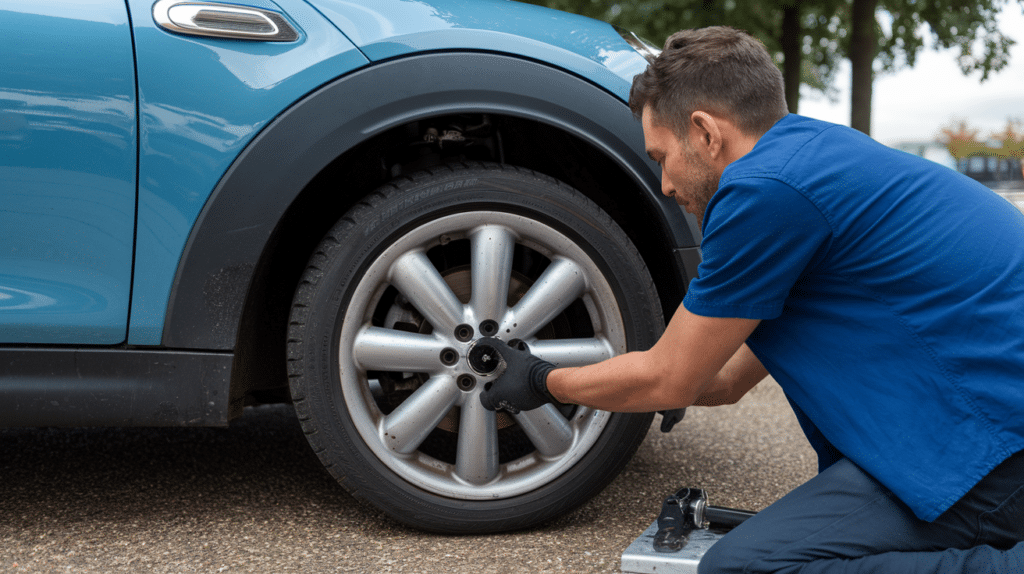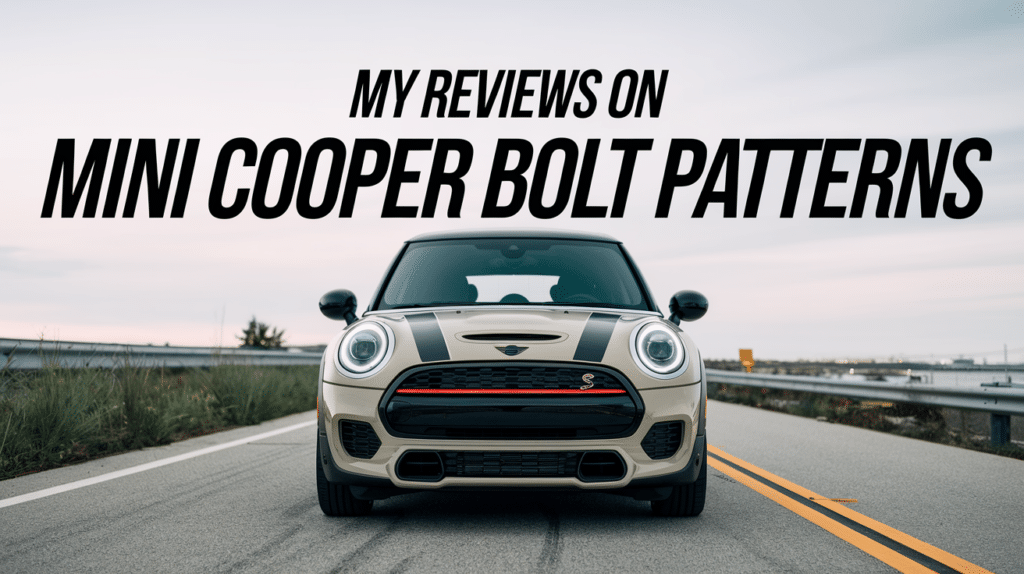Let me tell you about my experience with MINI Cooper bolt patterns – and trust me, it’s been quite a ride!
As someone who’s spent years working on these charming British machines, I’ve learned that getting the bolt pattern right can make or break your wheel setup.
Problems? Oh, I’ve seen plenty – from mismatched patterns causing vibrations to expensive wheels that just wouldn’t fit.
But don’t worry, I’ve got solutions for all of them. Through years of trial and error (and yes, some costly mistakes), I’ve mastered the art of MINI Cooper bolt patterns.
Today, I’m pumped to share my personal insights about everything from classic Mini’s 4×101.6mm pattern to the modern Cooper’s 4x100mm setup. Let’s dig into what really works, what doesn’t, and why it matters for your MINI.
What Is the Bolt Pattern for A Mini Cooper?

The Mini Cooper uses different bolt patterns depending on the model and year.
Most modern MINI models (2001-present) use a 4×100 bolt pattern, meaning they have 4 lug nuts arranged in a circle with 100mm diameter. This is common across the standard Cooper, Cooper S, and many other variants.
However, some higher-performance models like the John Cooper Works GP and certain special editions use a 4×114.3 bolt pattern for enhanced stability and to accommodate larger brake systems. The center bore (the hole in the middle of the wheel) is typically 56.1mm across most MINI models.
It’s worth noting that pre-2001 classic Minis used a different pattern – a 4×101.6 bolt pattern (or 4×4 inches).
When looking for replacement wheels, it’s crucial to verify your specific model’s bolt pattern as using incorrect specifications can lead to safety issues and improper wheel fitment.
Understanding Mini Cooper Bolt Patterns and Their Compatibility

The Standard Mini Cooper Models (2001-2023)
Predominantly use a 4x100mm bolt pattern, which includes base Cooper, Cooper S, and Clubman variants.
These wheels typically have a center bore of 56.1mm.
It can be interchanged across most modern MINI models with the same pattern.
High-Performance MINI Models
High-performance MINI variants like the John Cooper Works GP editions utilize a 4×114.3mm bolt pattern.
This larger pattern accommodates enhanced brake systems and performance wheels.
These wheels are not interchangeable with standard Cooper models due to the different bolt spacing.
Classic Mini Models (Pre-2001)
Classic Mini models (pre-2001) feature a 4×101.6mm bolt pattern, equivalent to 4×4 inches.
These wheels are specifically designed for vintage Minis and are not compatible with modern MINI Cooper generations due to the different bolt spacing and hub design.
MINI Countryman and Paceman Models
The MINI Countryman and Paceman models (2010-2023) also use the 4x100mm pattern.
It maintains compatibility with other modern MINI wheels.
However, these models often require specific wheel offset ranges due to their larger body size and different suspension geometry.
Modern Minis
When Upgrading or Replacing Wheels, the Lug Nuts for Modern Minis typically require a 17mm Socket Size.
While the center bore must match the 56.1mm specification to ensure proper fitment and centering on the hub.
A List of Correct Bolt Patterns for Different Mini Cooper Models
| Mini Cooper Model | Year Range | Bolt Pattern | Center Bore | Lug Nut Size |
|---|---|---|---|---|
| Classic Mini | 1959-2000 | 4×101.6mm | 62.0mm | 1/2″ UNF |
| MINI Cooper (R50/R53) | 2001-2006 | 4x100mm | 56.1mm | M17x1.5 |
| MINI Cooper S (R53) | 2001-2006 | 4x100mm | 56.1mm | M17x1.5 |
| MINI Cooper (R56) | 2007-2013 | 4x100mm | 56.1mm | M17x1.5 |
| MINI Cooper S (R56) | 2007-2013 | 4x100mm | 56.1mm | M17x1.5 |
| MINI Clubman (R55) | 2008-2014 | 4x100mm | 56.1mm | M17x1.5 |
| MINI Countryman (R60) | 2010-2016 | 4x100mm | 56.1mm | M17x1.5 |
| MINI Paceman (R61) | 2013-2016 | 4x100mm | 56.1mm | M17x1.5 |
| MINI Cooper (F56) | 2014-present | 4x100mm | 56.1mm | M17x1.5 |
| MINI Cooper S (F56) | 2014-present | 4x100mm | 56.1mm | M17x1.5 |
| MINI Clubman (F54) | 2015-present | 4x100mm | 56.1mm | M17x1.5 |
| MINI Countryman (F60) | 2017-present | 4x100mm | 56.1mm | M17x1.5 |
| John Cooper Works GP | 2020-present | 4×114.3mm | 56.1mm | M17x1.5 |
Ways to Identify the Correct Bolt Pattern for A Specific Mini Cooper Model
A Simple Check Your Car’s Manufacturing Year and Model
- The easiest way I’ve found to identify your MINI’s bolt pattern is to simply check your car’s manufacturing year and model
- Most modern MINIs (2001 onwards) use a 4x100mm pattern, while the classic ones (pre-2001) use 4×101.6mm
- I recommend snapping a quick photo of your car’s info plate under the hood – it’s a goldmine of information
- This method has saved me from countless headaches, especially when shopping for wheels online
- Keep in mind that special editions might have different patterns – always double-check if you’ve got a JCW or GP model
A Hands-On Approach
Grab a measuring tape and measure from the center of one lug hole to the opposite hole for accurate measurements.
I always clean the hub area first to ensure nothing interferes.
Also, don’t forget to measure the center bore – it’s just as important as the bolt pattern.
This method works great when you’re at a wheel shop trying to match patterns
Remember to measure multiple times for accuracy – I usually do it three times.
My Foolproof Method
- Online wheel fitment tools are my go-to for quick verification of MINI bolt patterns
- TireRack and Wheel-Size.com are my trusted resources for avoiding costly mistakes
- Always check your manual’s specs against the online tool’s recommendations
- Remember to input every detail – model, year, and trim level matter a lot
Checking Your Owner’s Manual
Check your MINI’s manual first – it’s the most reliable source. Head to the technical data section where you’ll find all the wheel details.
Most people prefer keeping a digital copy on their phone for easy reference while shopping.
No manual? Just download one from MINI’s website.
Everything you need is there, from torque specs to compatible wheel sizes. Save that wheel specs page – you’ll use it more than you think.
Pro Tips
- Take clear photos of your wheel and VIN from multiple angles – it’s your wheel’s ID card
- Keep all your wheel specs in one document on your phone – this saves time!
A Comparison Between Mini Cooper’s and Other Brands’ Bolt Patterns with Prices
| Brand & Model | Common Bolt Pattern | Center Bore | Average Wheel Price Range (USD) | Compatible with MINI? |
|---|---|---|---|---|
| MINI Cooper (Modern) | 4x100mm | 56.1mm | $150-$400 | Base Reference |
| VW Golf/GTI | 5x112mm | 57.1mm | $200-$450 | No – Different pattern |
| BMW 1/2 Series | 5x120mm | 72.6mm | $250-$600 | No – Different pattern |
| Fiat 500 | 4x98mm | 58.1mm | $120-$300 | No – Close but incompatible |
| Honda Civic | 4x100mm/5×114.3mm | 64.1mm | $150-$350 | Partial – Some 4×100 wheels fit |
| Toyota Corolla | 5x100mm | 54.1mm | $140-$320 | No – Different pattern |
| Audi A3 | 5x112mm | 57.1mm | $220-$500 | No – Different pattern |
| Mazda 3 | 5×114.3mm | 67.1mm | $160-$380 | No – Different pattern |
| Mercedes A-Class | 5x112mm | 66.6mm | $250-$550 | No – Different pattern |
| Ford Focus | 5x108mm | 63.4mm | $140-$350 | No – Different pattern |
Additional information:
- Prices are for standard aftermarket wheels, excluding premium or special editions
- Some Honda Civic models share MINI’s 4x100mm pattern, but adapters might be needed due to different center bores
- While some patterns may seem close, using incorrect fitments can be dangerous
- Prices may vary based on region, material, and design
- Always verify compatibility with a professional before purchasing
How to Maintain Bolt Patterns on Your Mini Cooper

For Modern MINI Coopers (2001-present):
I recommend regularly checking your lug nuts’ torque specs – they should be at 85-90 ft-lbs.
I’ve noticed that over-torquing is a common mistake that can damage the bolt pattern threading.
Pro tip: use a torque wrench every time you rotate your tires, which should be every 5,000-7,000 miles.
For Classic Minis (Pre-2001):
These older models require extra attention to prevent rust around the hub area.
I always clean the mounting surface with a wire brush and apply a thin coat of anti-seize compound (but never on the lug threads!).
This has helped me maintain the integrity of the bolt pattern on my classic MINI for years.
For John Cooper Works GP Models:
Since these performance models often see more aggressive driving.
I make it a habit to inspect the lug holes for any signs of elongation or wear after track days or spirited driving sessions.
Also, never use impact wrenches on these – hand torqueing is crucial for maintaining the precision of the larger bolt pattern.
Temperature Consideration for All Models:
When you’re switching between summer and winter wheels, let your MINI cool down completely before removing the wheels.
I learned the hard way that heat expansion can affect torque readings and potentially stress the bolt pattern.
Now I always wait at least an hour after driving before any wheel work.
For Countryman and Paceman Models:
These heavier vehicles put more stress on their 4x100mm patterns.
I recommend using a star pattern when tightening lug nuts and doing a secondary torque check after 50-100 miles of driving.
This has helped me prevent any loosening issues that can damage the bolt pattern over time.
Conclusion
Thanks for sticking with me through this into MINI Cooper bolt patterns! After breaking down everything from the classic 4×101.6mm to the beefy JCW GP’s 4×114.3mm setup.
I hope you’re feeling more confident about your MINI’s wheel fitment needs.
Remember, getting your bolt pattern right isn’t just about measurements – it’s about keeping your MINI running safely and smoothly.
By the way, if you enjoyed this guide, you might want to check out my recent piece on Tesla Model 3 bolt patterns.
It’s interesting to see how these modern EVs handle their wheel setups compared to our beloved MINIs!
Got questions about your specific MINI’s bolt pattern? Drop a comment below – I love helping fellow MINI enthusiasts get their wheel game just right.
Until next time, keep those wheels spinning true!


